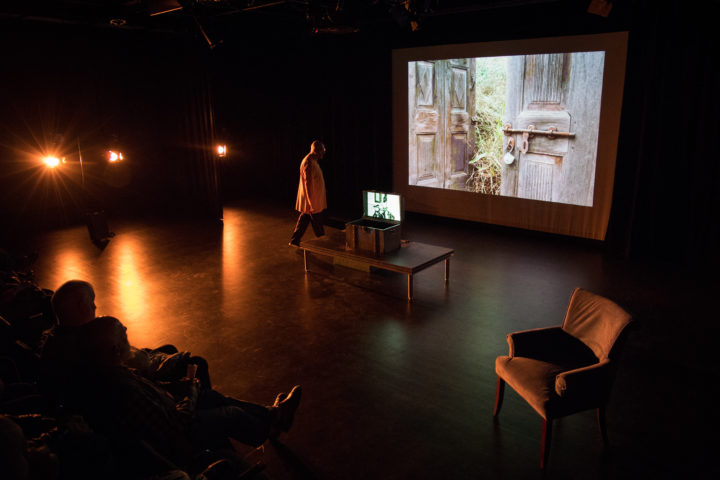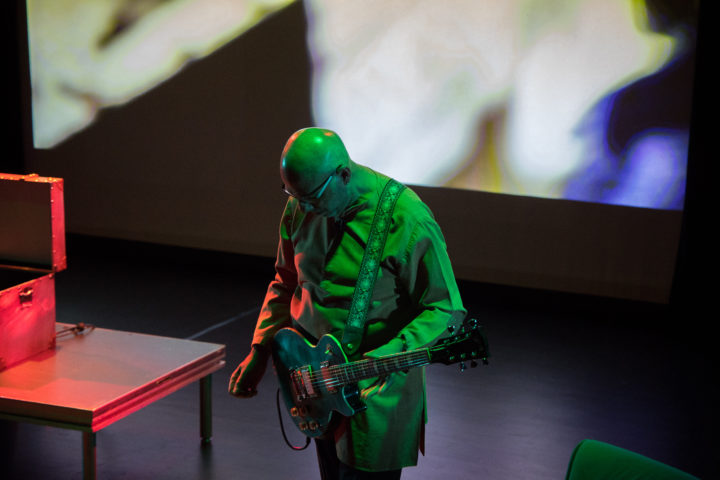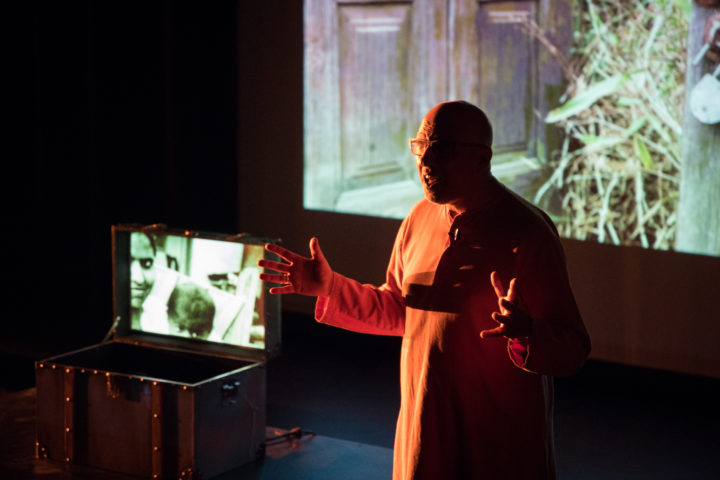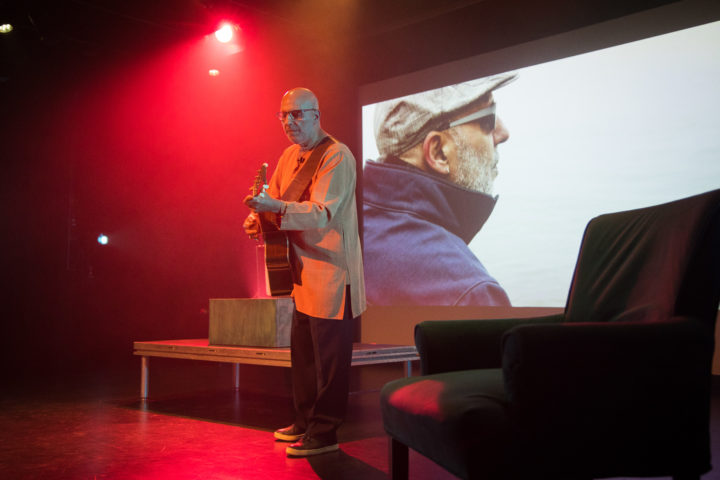
Introduction
Panj, a solo performance seamlessly combining storytelling, spoken word, song, images, video and original live psychedelic-rock-fusion music, premiered in Montréal at the Festival Accès Asie (Asian Heritage Month) in May 2022. The show is based on creator Himmat Singh Shinhat’s own history and story, and is fuelled by his desire to find a way to honour the memory of his father, Harchand Singh Shinhat.
The backdrop of Himmat’s family history is the Partition of Panjab into India and Pakistan, and the massacres and exodus it unleashed. This year marks 75 years since nations were forcibly carved out of the subcontinent. Dividing lines for the territories of Panjab and Bengal were drawn by Sir Cyril Radcliffe, Chairman of the Boundaries Committees in England, who was given five days to complete the task. National boundaries were drawn in secret 7,000 miles away and were not revealed until two days after the actual partition took place. His mother’s story in Panj-her name is Surjit Kaur Birdi - is one of countless stories of the million people who were killed and the 15 million who were displaced.
Veena Gokhale interviewed Himmat Singh Shinhat in August 2022.

VG: Himmat, could you please give us the story of Panj in a nutshell?
HSS: Panj operates on a number of levels and there are various threads running through the story. Each of these narratives represents a journey of sorts – geographical, social, political, personal or psychological. On a psychological level, the story follows my struggle to accept and heal from the loss of my father in 2006. (He was diagnosed with Streptococcus G, the flesh-eating disease, just after his 75th birthday.) On a personal level, it’s about finding resolution to my doubts about whether my father still loved me after I came out as queer. The backdrop of the story is the decolonization of the British Empire, the birth of the nation of India and the subsequent migration of my family to England and later on to Canada.
VG: Why the name Panj?
I’m really into numerology and things esoteric. (Laughter.) It’s my guilty pleasure. “Panj” means five. “Punjab” means the land of five rivers, the region of India where my parents are from. These words are Persian in origin. Also, there are five members of my family – my parents, myself and my two sisters. Five is also a number of great significance in Sikh history and culture. The first Sikhs – the Panj Pyare (the five beloved ones) – baptized by Guru Gobind Singh in Anandpur in 1699 were five. Orthodox Sikhs wear five symbols of their faith. I structured the piece in five “movements,” an oblique reference to the often-used structure of five movements in a classical symphony. I used five different guitars for the music for the show… You get the picture. (Laughter.)
VG: I do indeed! What were the key reasons for you to get behind this piece, Himmat?
HSS: I was particularly motivated by the desire to find a way to honour my father’s memory. He belonged to a generation of parents who made such great sacrifices to bring their families out west after political independence. I also wanted to share my journey of healing and discovery through my art. I had been suffering emotionally for many years from the loss of my father. I needed to heal. I quit my work in Ottawa in 2017 to come back to Montréal to be closer to my mother, who helped me through that difficult time and talked about my father’s past. I re-established my meditation practice and started EMDR [Eye Movement Desensitization and Reprocessing] therapy in parallel. In each of these contexts, I started to excavate memories of my father that would ultimately become the stories presented in Panj.
VG: Panj shows you as a teenager in Britain, letting your hair down, so to speak, and getting involved and inspired by the local music scene. Please tell us about your musical journey from there to here.
HSS: My father was the one who planted the seed of music in my heart. I remember him sitting at his harmonium singing shabads and ghazals. He had such a beautiful voice. I can still picture him recording music off the All-India Radio shortwave broadcasts. He would make mixtapes of shabads, ghazals and Bollywood hits that he would play in our home all the time. This was the soundtrack to my childhood!
Growing up in England, I studied classical music, piano, violin, music theory, choir and orchestra at school. My music teacher, Mr. Rust, encouraged me to compose my own music and perform it in front of the class. He was very open-minded and would invite students to bring their favourite music selections to class. It was there that I first heard music the likes of which I had never heard before – Led Zeppelin and Black Sabbath, Pink Floyd and Jimi Hendrix – my mind was blown. (Laughter.)
VG: I bet!
HSS: I just had to learn how to play the guitar to be able to play music like what my friends were listening to. So I started borrowing my sister’s folk guitar when she wasn’t looking. I would put my dad’s microphone through the sound hole and use his cassette player as an amplifier. My father bought me my first electric guitar after we moved to Canada. I played in a couple of garage bands on the South Shore of Montréal for a few years. As I was finishing university, the first wave of punk rock was in full force here. I joined the Alpha Jerks, a raucous punk band, and later fronted my own band, the Popular Front, a psychedelic, art-pop band that toured across the province for a couple of years.
After playing in the club and bar scene for a few years, I needed to break free from the constrictions of that environment, and I started writing my own music again. It was at this point that I found my musical voice, which fuses all of these influences into what I call “Psychedelic Rock Fusion.”

VG: What a journey! In terms of background context, it is clear that the Partition of India is central to your story, as is your Sikh heritage. Can you tell us about your earliest understanding of these key factors and how you view them now, in the complex, contemporary ethos of the 2020s?
HSS: My initial exposure to stories of Partition was through my parents, particularly my mother’s family’s experience. Her family’s village, Sidhar, was quite close to what would become the border between Pakistan and India.
Moti Ram, my maternal great-grandfather, was a thekedar (a contractor) and a philanthropist of sorts. He believed in and practiced the values of Guru Nanak, the founder of Sikhism. He was a successful entrepreneur. Many of his employees were Muslims. When the sectarian Hindu-Muslim conflicts started, he took them into his own home to protect them and to help them escape to Pakistan. He struck a deal with a business associate to have a bus take the workers to Pakistan under cover of night. After receiving threats of retribution against him and his family for what he had done, my great-grandfather was forced to abandon his land, his home and everything he had. In all the turmoil he had to flee with his family by train to find sanctuary in the colony of Dayalbagh, in Agra, where I was born.
It’s tragic looking back at the birth of India now. There was so much bloodshed at that time, but there was great hope for a secular and inclusive democracy. Seventy-five years later, the current government has put in place a brutal, authoritarian regime that has been undeterred in suppressing dissent with impunity. Sadly, we are now also seeing the resurgence of Hindutva, Hindu fundamentalism, and the oppression of minorities in India.
VG: Yes, it is terrible. Your family already belonged to a minority group – the Sikhs – in India. Your father wore a visible religious symbol, a turban, all his life. How did this, as well as your homosexuality, shape your perception of the world? How did it influence Panj?
HSS: My parents made a lot of effort to transfer Sikh values to their children, but they were not dogmatic at all. I think my perception of the world is very much shaped by those values, even if I’m not an orthodox Sikh. Guru Nanak’s teachings, in particular, have enormous meaning and relevance for me in the world we live in today.
My mother came from a family of entrepreneurs and my father from a family of engineers. He was perhaps the more traditional of the two; it was important for him that we maintain Sikh traditions. I remember how he was deeply hurt when I cut off my kesh (hair) just before starting grammar school in England. At the same time, he would come to my musical performances of psychedelic rock and he would have a great time listening to the music and taking photographs. Being a teacher, my mother was very open and curious, so when I started meditating using a Buddhist approach, she actually asked me to teach her how to meditate that way.
There was and there still is a lot of racism in England. As orthodox Sikhs, my father and mother were easy targets for racist and discriminatory behaviour. I felt the burden that my parents had to carry, without necessarily having a perfect understanding of their challenges until I was older. My mother really pushed us to get a good education. She was perhaps better than my father at making strategic choices, culturally and socially.
In terms of my queer identity, I have never really identified with the mainstream white gay ethos or aesthetic. I didn’t see myself reflected at all in the images presented in mainstream gay media. There was very little BIPOC [Black, Indigenous, People of Colour] representation in those days. In the 1990s, I helped start a collective of queer South-Asian artists called Saathi, which means companion. There were no models or reference points for us as queer South Asians, so a number of us were exploring different ways in which to express a particular queer South-Asian identity.
My intent with Panj was also to address the dearth of artistic narratives around queer Sikh identities. I also felt that it was important for me to challenge the heteronormativity that pervades our communities.

VG: Going back to Panj, a multidisciplinary show like that is a very complex undertaking. Please tell us about that journey.
HSS: Part of my research was a series of lengthy discussions with my mother. Originally, our intent was (and still is) to write a book about our family history. I was still processing the loss of my father, Harchand, when I started Panj. So part of our process was sharing memories of him with each other. The narratives around me and my dad and our relationship were really interesting and poignant, and as I reflected on them, a “story” started to emerge that would ultimately become the core of Panj.
The poem I perform in the prologue, “A Walk on the Beach,” was actually written in Cuba after walking along the beach with my mum as the sun was rising! She and my father used to go there together every winter before he died. I’d been there for a couple of days and felt the presence of my father very strongly that morning, and the sounds and the sight of the sea started to suggest words as we walked. I ran back to the hotel room and wrote down as much as I could. The music for this scene, “Blues for Harchand,” was also composed in Cuba, originally on my iPad!
I have two albums of my Dad’s black and white photographs from the 1950s and the early 1960s that are very precious to me. I scanned a number of the images you see during the performance. I also had boxes and boxes of his photos from the 60s, 70s, 80s, and 90s! I wanted his creativity to be part of the show. It was so much fun making the videos with Laurence Ly, who did all of the montage of the stills as well as recording original footage of my mother and me packing the peti (a trunk).
It was indeed challenging to carry forward the live “one-man show.” I had a lot of responsibility all through the process. That said, I received incredible support from friends and family. My lovely mother, Surjit Kaur, was there from start to finish. Farah Fancy of Le Groupe Herencias supported me through the creation and production phases, in the capacity of an “artist doula.” I had a handful of alpha and beta readers with whom I shared the script as it evolved. Montréal writer Rana Bose coached me for the acting and voice, and former ELAN (English Language Arts Network) Executive Director, Guy Rex Rogers, gave me generous feedback and writing advice on the script.

VG: So tell us about the peti that you just mentioned. It travelled from Punjab all the way to Montréal, in this story. Do you still have it? And what do you keep in it?
HSS: The peti is a motif that emerged through the writing process. It is an old-fashioned trunk made for storage and travel. For me it works on a number of levels. I think it speaks to the idea that when we migrate, we can’t always take everything with us. Whether migration is voluntary, or forced, as it was for the people of Punjab displaced through Partition, what do you choose to take? What do you leave behind? Sometimes, your memories are all you can take with you…
Part of my creative process for Panj was through meditation, which helped me “unpack” some of the memories and experiences around the loss of my father. So, at another level, I think the peti also represents the body and how we carry our memories and our experiences throughout our lives in our bodies and minds.
My wooden peti, the one I talk about in Panj, was actually made for me by my father for my 40th birthday. It is very precious to me and has a prominent place in my home. It represents a link back to my father and to my heritage. My father’s family are Ramghariya Sikhs. Historically, they were revered for their skills in woodworking and carpentry, so the peti he made for me is a tangible expression of that history.
Over time, I have been collecting things associated with my father that are particularly meaningful for me, and I keep them in the peti. I have his very first camera, the two old photo albums he brought with him from India to England, his technical drawing instruments he used as an engineer, an old turban, a worn-out cotton flannel shirt that he used to wear when he was working in the garage. I think he may even have worn the shirt and the turban while he was making the peti for me!

VG: You come across as a well-integrated person who has overcome challenges and drawn from and fused myriad influences into a creative and positive whole. What were some of the most challenging moments you have faced, both personally and in the creation of Panj?
HSS: With Panj, I wanted to create something that would resonate for “children” of the diaspora. The story of Panj itself relates many of the challenges that I and my family have faced. I think many of my challenges are perhaps common to people who were born in the diaspora or grew up here from an early age, like I did.
For the creation of Panj, one of my key challenges was maintaining balance. On the one hand, pursuing my path to heal from the loss, and on the other, excavating stories that sometimes would bring me right back into the heart of my sadness, retriggering the grief. The loss was further compounded by the silence between my father and me about my sexual identity. There was unfinished business, questions that were unresolved, and things I had wanted to share with him that I never did.
It was a priority for me to remain authentic. The story was very personal but I also wanted it to be as relatable as possible. It was certainly a challenge to come from a place of such great vulnerability and then express that vulnerability in front of an audience.
One of the key insights that emerged for me from the experience of doing Panj was the recognition of my father’s unconditional love for me. My doubts about his love for me were completely unfounded. On a more universal level, I wanted to recognize the burden that our parents carried as migrants and the incredible sacrifices they made for us.
In those moments when the sadness is most heavy, I’ll open the peti my dad made for me and look through the artifacts I keep inside that belonged to him. Sometimes as I’m sitting by the peti, I’ll talk to him, too, share with him what is going on in my life, tell him how I’m feeling, or seek his help and his advice, laugh with him, weep at times, too… He’s always there for me. Oh, and I don’t filter out issues related to my sexual identity with him anymore! (Laughter through tears)
VG: I am so touched that you have shared all this with us. Thank you, Himmat. Where next with Panj? Any plans for a rock opera?
HSS: Given all the time and energy invested in the creation of Panj (I started in 2017), and the generous positive feedback I received from audiences at the Montréal showings, I’m certainly hoping to present the live show again, both here in Montréal and in other cities. I’m also looking at whether there are different formats to manifest the piece – maybe a book, a film, a series of podcasts. It would be fun to release the music from the show as a stand-alone album!
I really enjoyed working this way. The multidisciplinary approach gave me multiple modes to carry the story. It allowed me to choose the best medium at any given moment in the show to convey the idea being presented. As work on the piece evolved, I also started to look at how the various media interact. Once the basic ideas were there, a lot of the nuance and poignancy came from playing around with the way in which the different media interacted. I feel like my artistic practice has evolved through this experience, so I definitely want to continue on this path.
A lot of the research for Panj was done through interviews with my mother. I have archived all of that material and want to return to it, because I would like to do something with and about my mother. I also want to carry on doing music, my principal medium. Panj was a very heavy burden to carry because I was going it alone pretty much, so I’m also exploring the idea of doing a collaboration. I really miss playing live music and I love your idea of a rock opera. A Psychedelic Rock Fusion opera sounds like just the ticket!
VG: Yah, way to go!
Himmat Singh Shinhat
Himmat is a composer, professional musician and interdisciplinary artist. His compositions have been used in solo performances, soundtracks for theatre, film, contemporary dance and performance art. He grew up in England and arrived in Montréal in the fall of 1976, becoming part of Montréal’s first surge of punk/new wave music. Himmat’s contemporary musical pieces constitute a fusion of his influences and the tensions between them. His work is informed by his education in western classical music, Sikh religious music, Bollywood soundtracks, the Indian classical and folk music that he heard in his childhood home, and contemporary popular music.
He has played a leadership role in building and supporting arts infrastructure in Montréal. Himmat is past president of Montréal arts interculturels (MAI) and sits on the board of the Festival Accès-Asie. He is active on Montréal Serai’s Advisory Board and was one of its founding members.
For more on Himmat Singh Shinhat’s art, please visit his website.
Veena Gokhale
Montréal-based author Veena Gokhale teaches ESL and Indian veggie cooking, writes fiction as well as articles and reviews, and curates literary events. For more information, visit Veena’s website and Facebook page.








